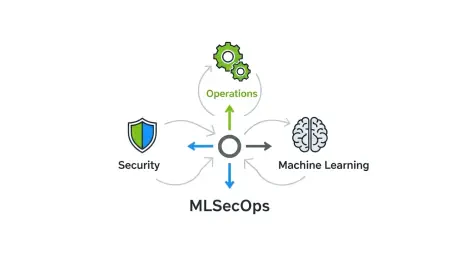Imagine a world where a single malicious input can derail an autonomous vehicle’s decision-making system, or a compromised dataset in a healthcare model exposes sensitive patient information. With machine learning (ML) now powering critical operations across industries, the stakes for security have never been higher. MLSecOps, an innovative framework blending security, governance, and observability into the ML lifecycle, stands as a vital solution to these pressing risks. This review dives deep into how this emerging discipline addresses the unique vulnerabilities of ML systems, ensuring not just efficiency but also trust and compliance in high-stakes environments.
Defining MLSecOps: Security at the Core of ML
MLSecOps represents a transformative shift in how security is integrated into machine learning workflows. Unlike traditional CI/CD pipelines or even MLOps, which often emphasize speed and automation, this framework embeds protective measures at every stage—from data ingestion to model deployment. It tackles specific threats like adversarial attacks and data poisoning, which are unique to ML and can have catastrophic consequences if left unchecked.
The relevance of MLSecOps extends across the technological landscape, particularly as industries increasingly rely on AI for decision-making. With trust in AI systems becoming a cornerstone for adoption, especially in regulated sectors, the framework’s focus on accountability and resilience positions it as a critical tool. It ensures that innovation does not come at the expense of safety, addressing a gap that older methodologies fail to bridge.
Key Features of the MLSecOps Framework
Lifecycle-Driven Security Integration
A standout feature of MLSecOps is its structured lifecycle approach, spanning planning, threat modeling, data handling, model validation, deployment, and continuous monitoring. Each phase incorporates targeted controls to mitigate risks, such as encryption during data engineering to prevent breaches or adversarial testing during validation to catch deceptive inputs. This comprehensive strategy ensures that vulnerabilities are addressed proactively rather than reactively.
Beyond just risk mitigation, the lifecycle fosters governance by embedding compliance checks throughout. Whether it’s adhering to privacy laws or ensuring model fairness, the framework provides a roadmap for maintaining ethical standards. Its adaptability allows organizations to tailor security practices to their specific needs, making it a versatile solution for diverse ML applications.
Collaborative Ecosystem for Risk Management
Another defining aspect is the emphasis on cross-functional collaboration. MLSecOps unites data scientists, engineers, and security experts to anticipate and neutralize threats at every pipeline stage. This synergy ensures that technical innovation aligns with robust protective measures, creating a seamless integration of expertise.
Such teamwork is vital in complex ML environments where risks can emerge unexpectedly. By fostering communication across traditionally siloed roles, the framework enables a shared responsibility model. This not only enhances system integrity but also accelerates the identification and resolution of potential issues before they escalate.
Adoption Trends and Industry Shifts
The growing adoption of MLSecOps reflects a broader recognition of ML security as a business imperative. As machine learning transitions from experimental projects to core operational drivers, companies are prioritizing frameworks that balance speed with safety. This shift is evident in sectors where even minor breaches can lead to significant financial or reputational damage.
A notable trend is the convergence of security and operational practices within ML pipelines. Automation plays a pivotal role here, with tools scaling protective measures to match the complexity of modern systems. Industry consensus now views traditional CI/CD as inadequate for ML’s unique challenges, cementing MLSecOps as the emerging standard for secure deployment.
Practical Impact Across Sectors
MLSecOps demonstrates remarkable adaptability in real-world applications, securing ML systems in varied domains. In finance, it fortifies fraud detection models against manipulative inputs while ensuring regulatory adherence. Healthcare benefits from privacy-preserving techniques that safeguard patient data during diagnostic model training, aligning with strict standards like HIPAA.
In autonomous systems, the framework’s adversarial testing and rollback mechanisms enhance safety by preparing models for unexpected scenarios. Retail, meanwhile, leverages drift detection to maintain the accuracy of recommendation engines, preserving customer trust. These examples highlight how MLSecOps enables rapid yet secure deployment, building confidence among stakeholders in critical industries.
Challenges in Implementation
Despite its strengths, MLSecOps faces significant technical hurdles. Securing continuous training against data drift or real-time adversarial inputs remains a complex task, often requiring sophisticated monitoring solutions. These challenges are compounded by the dynamic nature of ML systems, where threats evolve alongside data and usage patterns.
Regulatory compliance adds another layer of difficulty, with laws like GDPR demanding transparency and explainability in AI processes. Integrating bias audits and maintaining audit trails can strain resources, particularly for smaller organizations. While tools for governance are advancing, the lack of standardized protocols continues to pose obstacles to widespread adoption.
Looking Ahead: The Evolution of MLSecOps
The future of MLSecOps holds promise with potential advancements in automated security tools that streamline threat detection and response. Broader adoption of lifecycle-based approaches could standardize best practices, making secure ML more accessible. Innovations in explainability features may further enhance trust by clarifying model decisions in regulated environments.
Breakthroughs like unified AI security protocols could simplify compliance across borders, easing the burden on global enterprises. As these developments unfold, scalability will likely improve, allowing even resource-constrained teams to implement robust protections. The long-term impact points to a landscape where ethical and resilient ML systems become the norm rather than the exception.
Final Reflections on MLSecOps
Looking back, this review highlighted how MLSecOps redefined secure machine learning deployment through its lifecycle focus and collaborative ethos. It stood out as a framework that balanced rapid innovation with stringent accountability, addressing risks that traditional methods overlooked. Its practical applications across industries underscored a capacity to adapt to diverse challenges with precision.
Moving forward, organizations should prioritize integrating MLSecOps into their ML strategies, starting with cross-team training to foster collaboration. Investing in automated tools for monitoring and governance can alleviate implementation burdens, while staying abreast of evolving standards will ensure compliance. As threats grow more sophisticated, adopting this disciplined approach will be essential to safeguarding the future of AI-driven operations.









